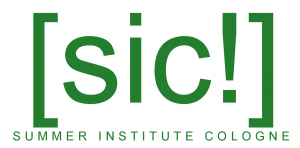 Das 7. internationale Sommerinstitut der Universität zu Köln für Master-Studierende und Doktorand_innen findet dieses Jahr von 26. August bis 6. September rund um das Thema „Imprints • Media • History“ statt.
Das 7. internationale Sommerinstitut der Universität zu Köln für Master-Studierende und Doktorand_innen findet dieses Jahr von 26. August bis 6. September rund um das Thema „Imprints • Media • History“ statt.
Tom Gaubatz (Northwestern University) und ComFor-Vorsitzender Stephan Packard (Universität zu Köln) bieten dabei ein englischsprachiges Seminar zu „Comics, Caricatures, and Cartoons in Comparative Perspectives“ an.
Bewerbungen können noch bis zum 22. März 2019 eingeschickt werden (siehe Call for Participation).
Seminarbeschreibung:
„This seminar will examine one of the basic aesthetic movements in comics: the production of depictions that simplify, exaggerate, or distort depictions of bodies, voices, and subjectivities.
Comics famously present characters in absurd shapes: In Spiegelman’s MAUS, we see Artie’s mood by glancing at his mien – but do not know the shape of his face, which is replaced by the mouse head representing the racist ascription of a ‘Jewish’ identity. Seemingly more harmless, similar semiotics apply to uncertainties concerning body masses of muscular super heroes, respective body sizes of Franco-Belgian cartoon Gauls, and Donald Duck’s oscillation between man and duck.
One approach to these issues is through the concept of caricature. Caricature appears to represent its object – most often a famous individual or a common social type – by simplifying its form and exaggerating or distorting its characteristics, often with humorous or derisive intent. This representational premise obscures many semiotic nuances: social types may not exist a priori but rather be constituted through the act of representation, and such representation may only be possible through stylization. Indeed, it is arguably because of such inversions that caricature is a powerful symbolic operation and ideological tool for shaping popular perceptions of social reality.
Another approach to these aesthetics follows Scott McCloud’s (1993/4) new coining of the term ‘cartoon’. As an artform, comics will often depict bodies by means of visual representations that distort or obscure the shape of the body itself – if, as with caricature, such a shape is assumed to be accessible in a shared social reality. But they will also use these distorted media artifacts where no such shared reality is readily available: There is no ‘real’ depiction of Art Spiegelman that could dissolve the contradictions of his self-representation in MAUS. More generally, then, cartoons will present bodies visually without showing what they look like.
While the terms ‘cartoon’ and, to a lesser extent, ‘caricature’ have often been used to refer to mostly visual media, we will attempt to broaden those concepts. The same differentiated relationship to ‘representational correspondence’ (Currie 2010) emerges in cartoonish and caricatured voices and other distorted soundscapes. We seek to explore more widely the theoretical issues surrounding such representations in various artforms, traditions, and cultures, as well as their uses across media and from historical, comparative, and interdisciplinary perspectives. Assuming that this semiotic phenomenon is always rooted in cultural, political, and historical contexts, we will branch out into examinations of distortion in gazes and depictions in various popular media.
Our exploration will be oriented by an interconnected network of tensions that emerge through the juxtaposition of comic, cartoon, and caricature. A tension between individual and type—caricature may exaggerate and concretize the singular attributes of the individual or abstract the general characteristics of a type, but individual and type are also constituted through one another—that may be illuminated by interrogation of the semiotic nature of caricature and of the relationships and interactions between visual, linguistic, and bodily performed signs. A tension between the pictorial and the corporeal that raises questions regarding the narratological status of the cartoon image and its function as a mode of inter-medial representation: is the cartoon a body itself or merely the picture of one, and how or when does it move between body and picture? What forms of narrative and narration does the cartoon body enable, and how do these narratives interact with the social realities of living bodies? A tension between the visible and the visual, continued in tensions between social categories deemed unmarked or universal and those marked as other by gender, race, class, or ability: here the marking operation of caricature must be understood in relation to historical and cultural regimes of identity, and to other adjacent modes of social knowledge production. Moving beyond a limited ahistoric and formal semiotic analysis, the cartoon body needs to be redifferentiated as emerging from a number of specific historical traditions, including the anatomical drawings of racist ideology, purportedly enlightened 18th century physiognomy and phrenology, and other operations of social typing and stereotyping.
Drawing both on the historical TWS collection at Cologne and on the international set-up of the Summer Institute Cologne, participants will introduce one another to historical and recent paradigms of comic, cartoon, and caricature, as well as analytical tools regarding the same.
We approach the concepts of comics, caricature, and cartoon not as master theoretical categories, but rather as a shared and flexible vocabulary to be developed, critiqued, and enriched through the comparison of cultural modes of gaze and representation. While our core focus is on comics, our exploration will follow participants’ interests and should cover a broad historical and cultural range of both visual and aural media: bring your own examples of visual and aural narrative and be ready to engage with everyone else’s.“